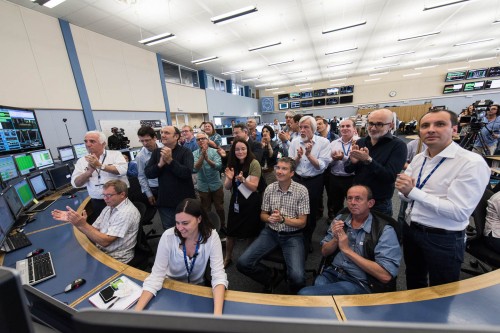
Celebration at CERN: physicists in the LHC control room applaud the first stable collisions. (Courtesy: M Brice/CERN)
By Hamish Johnston
Earlier today the first data of the 13 TeV run of the Large Hadron Collider (LHC) at CERN were collected by all four of the Geneva-based collider’s main experiments. I was up early this morning (8.00 a.m. Geneva time) and followed all the action live via a webcast from CERN. After losing the beams at about 8.40 a.m. because of a faulty beam monitor, collisions in the CMS, ALICE, ATLAS and LHCb experiments were being reported at 10.40 a.m.
This marks the beginning of the LHC scientific programme at 13 TeV. Physicists hope that the new collision data will tighten up our understanding of the Standard Model of particle physics. Much more importantly, they could also reveal flaws in the Standard Model that could point to new physics.
If all goes well, over the next few years we could be blessed with important clues about the nature of dark matter and even gain a few pointers about how to reconcile quantum mechanics with Einstein’s general theory of relativity.
“We have seen the first data beginning to flow,” said CERN Director General Rolf Heuer, who added “Let’s see what they will reveal to us about how our universe works.”
What could go wrong? The nightmare scenario for particle physicists is that the LHC will deliver loads of data supporting the Standard Model and not a thing about any new physics that might lie beyond. The LHC is expected to run for at least another 20 years, so let’s hope nature doesn’t take it down that road.
Like the Queen, the 13 TeV run has two birthdays. In March, physicsworld.com’s Tushna Commissariat travelled to CERN for an opening event while the collider was preparing for collisions. She spoke to a number of physicists about their hopes and dreams for this experimental run and you can read much more in her article “Large Hadron Collider fires up in a bid to shake up the Standard Model”.
If this run of the LHC only yields “Nightmare Scenario” II, i.e., once again nothing beyond the provisional and problematic Standard Model of particle physics, will theoretical physicists finally be willing to question the dubious assumptions that have failed them for 40 years regarding the unification of General Relativity and Quantum Mechanics, dark matter, dark energy, etc.?
One can only hope.
RLO
http://www3.amherst.edu/~rloldershaw
The so-called “nightmare scenario” just means that for the 13 TeV of the LHC, the particle SM stands up to the different results it produces. However, from the 13 TeV = 1.3. 10^13 eV to the ultimate Planck value of round 10^28 eV, there is a huge range of energy available in Nature, but may not be explored with the Earth-bound machines, but may be avaiable in cosmology. The 13 TeV LHC should tell us something about this and open a new dimension for the high energy physics.
Yes, to get to the dark matter or physics beyond the standard model one would be looking to pack matter particles so tightly together that they have to reform as matter with a smaller Planck length. (and that is nature’s way of escaping the problem of the singularity – because with a smaller Planck length the (now dark) matter is also given a smaller Gravity constant, and less energy per particle, so there is a recoil/explosion of energy (a gamma ray burst?).
But these conditions are way beyond the power of any Earth bound technology. They’re even more extreme than neutron stars. We need to look closer at Galaxy cores and GRB’s, with better telescopes, not particle colliders.